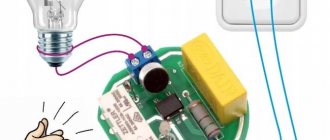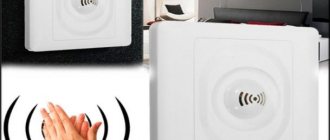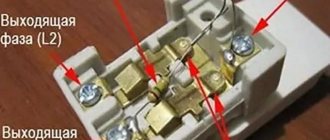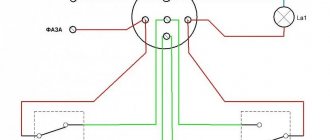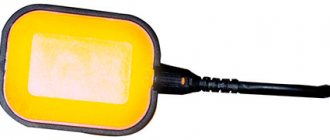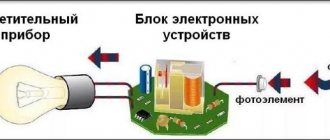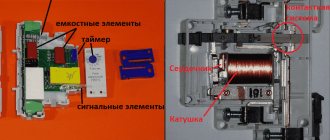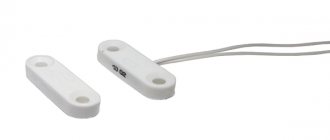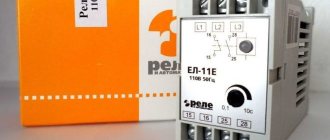A household switch, starting with a single-key switch, is a simple item that can be found in any apartment or house. This useful invention works quite simply. Although during the time of technical progress its design and appearance has undergone numerous changes. However, in essence, the operating principle is the same. With the exception, perhaps, of sound, and the method of extinguishing the arc in the chambers. Nowadays there is a very large selection of these devices, according to the method of application for every taste. It remains to tell a little about how the light switch works.
Single-key switch device
The main parts that make up a household single-key switch:
- base with fastening elements;
- movable panel;
- contact group with moving and fixed contacts;
- decorative elements.
The operating principle of a standard switch is to close and open an electrical circuit when acted upon. But this action depends on the difference in devices, the features of their design, and functionality.
The basic principle of operation of a standard switch is to close and open an electrical circuit
How to properly design corners on a ceiling plinth
Execution options
The circuit breaker design options differ in degree of protection IPxx. Two digits xx indicate the level of protection against solid objects and particles and against water. Depending on it, the area of application of the device is determined. For example, switches with IP 21 are only suitable for indoor use, while switches with IP44/54 are suitable for outdoor use.
Switches with an increased degree of protection can be used outdoors
There are also switches for surface mounting and built-in type. Surface mounted for use with exposed wiring. They are mounted on a lining. The second type is mounted in a recess on the wall into which the socket box is built. This installation comes with hidden wiring and is therefore more flexible. There is less chance of damaging something, but, on the other hand, there is more installation work.
How to correctly report data for electricity: how to transmit, when and in what way
Surface-mounted switch
Among the switch options, there is also a difference in rated load. It is fixed in the current or power that the device is capable of switching. The value indicated on the housing or in the specification must not be exceeded.
| Switch type | Device type | Load capacity of contacts, A |
| MAKEL Mimoza 12003 | Double key | 10 |
| Simon S27 | Button | 10 |
| Jilion 9533140 | Two-key pass-through | 10 |
| Bylectrica Praleska | Three-key key | 6 |
| Schneider Electric GSL000171 GLOSSA | Cross | 10 |
Replacing electricity meters: at whose expense is the electricity meter changed and in what case
Replacement procedure
How to replace an old switch? First, you will need to dismantle the outdated model, for which:
- Disconnect the wires;
- Carefully pry off the cover using a screwdriver;
- Take it out;
- Unscrew the internal screws for fastening;
- Remove the entire mechanism from the socket;
- Check for voltage in the wires;
- Remember (take a photo) of the wiring;
- Loosen (cut) the wires.
Installation of a new device includes:
- Inspection of wires to determine fraying;
- Cut off or wrap exposed areas with electrical tape;
- Carry out installation taking into account the fixed wiring in the reverse order of dismantling.
How does an illuminated light switch work?
Nowadays, switches equipped with a backlight circuit are gaining popularity. How does a light switch work with such an addition, which serves not only for beauty, but also performs certain functions:
- allows you to locate the switch in the dark;
- is an indicator of the disconnected state of the switching device;
- determines the integrity of the lighting circuit (and, in the case of using incandescent lamps, indicates the serviceability of the light bulb).
The backlit switch serves not only for beauty, but also performs certain functions
Meter box: requirements for a metal case for outdoor installation of a meter
A lighting circuit is formed on the device. In order for this design to work, a very small current is enough - a few milliamps. LEDs or miniature neon lamps are suitable for use in such conditions.
Illuminated switch diagram
The diagrams show how the switch works. If you turn off the main switching device, then a current flows through the LED, limited by the resistor and the resistance of the lamp. If the switch is closed, then the backlight circuit is bypassed and the LED does not light. When the lamp is turned off, the glow circuit is broken and there will be no light.
How to fix bluetooth headphones for a phone, if one doesn’t work, the microphone or plug is broken, the contact has come loose and other cases
In ancient times, when there were no backlit switches and incandescent lamps were predominantly used, the backlight circuit did not affect the operation of the circuit. When energy-saving and LED lamps came into use, even extremely low current flowing through the resistor and LED, in some cases, causes unpleasant flickering of the lamps. This problem can be overcome by shunting the lamp with a resistor of several kiloOhms or a capacitor.
Connection instructions
The various switch connection diagrams are similar to each other, but differ in some important details. Therefore, it makes sense to consider three different options related to the external and internal installation of products, as well as the method of switching in the junction box.
Outdoor Unit Installation
Purpose of the switch screws
The simplest way to connect a single-key switch on the surface of the walls is implemented according to the classical scheme. The phase conductor removed from the machine is connected to the lower terminal, and the phase conductor removed from the upper contact goes directly to the light source. In this situation, it does not matter how both of these conductors are laid: along the surface of the walls or covertly.
A correct connection is considered to be one in which the device itself is installed in the open phase wire. This rule is equally valid for all options under consideration.
Installation with hidden wiring
In the case of hidden cable laying in the thickness of the walls, the switch housing is placed in niches specially designed for this, and the wires are supplied to it through a plastic installation box. Upon completion of their connection to the terminals of the product, the housing with the box is recessed into the wall niche and fixed there with special screws. After this, all that remains is to close the switch frame with a decorative cover and install the switch key in its place.
To do all these operations as quickly as possible, you will have to use ready-made conductors and niches left over from the old switch. If the length of the aluminum conductor protruding from the wall is not sufficient for connection, you will have to increase it using a piece of copper conductor and a miniature adapter terminal block.
Connection via junction box
Wire connection diagram without grounding
To disconnect the switch through the junction box, you will need to perform the following operations:
- The withdrawn phase conductor is laid to the corresponding contact of the distribution unit.
- After fixing it, another wire is pulled to the lighting fixture.
- The neutral conductor is usually not required to be laid, since it is pre-laid in the thickness of the walls or ceiling up to the second terminal of the illuminator.
All procedures for opening a single switch are similar to the operations already described earlier.
Terminals for connecting wires and markings
So, to connect conductors to the switching device, two main types of terminals are used:
Screw and spring types of terminals are used for mounting the switch
- screw - the conductor core is clamped by tightening the screws;
- clamping (spring) - just insert the conductor, the spring-loaded platform will press it itself.
More convenient, of course, are spring ones, from the point of view that they are easier to install. Screw ones, in comparison with the previous ones, are more reliable. However, if the wiring is carried out with a cable with aluminum conductors, you should remember the ductility of this metal. Screw terminals require periodic tightening, otherwise bad contacts and the corresponding consequences cannot be avoided. Spring ones do not need tightening, since they tighten the wire themselves.
Color and alphanumeric markings of electrical circuits
Looking at the switch from the front, it is difficult not to notice the symbols. Their designation indicates the place where the device is used.
Photo and description
On conventional key light switches, you can find the designation I and O, which means the on and off position.
Rocker switch with I and O designations
Also, conventional devices that work only to open or close an electrical circuit can be marked with a key symbol.
Key switch with key symbol designation
Another type of switch is a push-button switch that does not lock in one position. Therefore, such switches can be used as bell buttons, or as switches in a lighting system assembled on the basis of pulse relays. They have a special marking in the form of a bell.
Push button switch
There are pass-through switches marked with a bidirectional arrow.
Overhead pass-through switch with bidirectional arrows
There are pass-through type devices; symbols in the form of steps are applied to them. .
Pass-through switch with staircase symbol for indoor installation
All these markings may or may not be present on the switch panel at all. Here you will not find uniform standards, so each manufacturer is free to apply signs at their own discretion. And often you come across a product, even among global brands, that often lacks any markings.
Tests and inspections, what devices are used to control
The operation of high-voltage circuit breakers requires the following checks:
- visual inspection for external defects;
- measuring the resistance of the insulating coating;
- checking the resistance of windings and contacts, when comparing the obtained value with standardized indicators;
- response time;
- contact temperatures and others.
Instrumental measurements are performed with a megger, thermometer and stopwatch. Also, to test devices, special stands designed to perform these types of work can be used.
Design of various types of switches
According to their purpose - to turn on and off an electrical device, switches of any type meet the requirements. But they differ from each other in design.
Key
The design that is most often found. How does a keypad light switch work? In one position the contacts are closed and the light is on, in the other they are open and the light is off. The key switch is divided into: single-key, two-key and three-key.
Key switch
Over time, the design of the key switch has remained virtually unchanged, with the exception of the decor of the plastic surface. Behind it there is an active movable panel that controls the contact group. All this is assembled on a supporting structure.
Button
As the name suggests, this type of switch is based on a button. There are two options for this device:
Push button switch
- With fixation . Works like a keyboard. When pressed for the first time, the button is locked in the on position. In the second case, it is pressed to the off position. It is used for lamps, built into them.
- No fixation . When pressed, the contacts close, when released, they open. Can be used for electric bells and impulse relay circuits. Designed for vertical plane.
Cord or rope
You've probably seen such a lamp more than once. This rope-type switch (on-off from a cord) can be built into wall lamps, or it can be a separate device designed to illuminate the entire room or part of it. It is controlled by pulling the string.
Rope or cord switch
How does a corded light switch work? The mechanism of such a lamp is more complex than its operating principle. The algorithm is simple - each manipulation of the rope changes the state of the contacts to the opposite:
- Pull the cord the first time and the light will turn on;
- pull a second time to turn it off;
- The third time it will turn on again and so on.
It works according to the closing-opening mechanism of the contact group. Such a switch, with a certain degree of assumption, can be called a mechanical implementation of a pulse relay.
Turning
These days, this is quite a rare specimen. Rotary switches make and open contacts when the handle is turned. Nowadays they are rarely used because they are not very convenient to use, except for decoration.
Rotary switch
But there are also modern switches that can be classified into this category. They are combined with dimmers - these are brightness regulators. To turn off the light, you need to turn the handle towards the minimum brightness and turn it until it locks. To turn off the light, turn the knob in the opposite direction.
Acoustic
Switch with sound response. There is a microphone built inside that picks up sound and converts it into an electrical signal, which in turn is amplified, filtered, and compared with a set threshold.
Acoustic switch
An acoustic switch will be an indispensable thing in a house or apartment where a person with impaired motor functions or visual impairment lives. If the sound level is exceeded, a command is generated to turn on or turn off the load. However, there is a possibility of extraneous noise effects, which may cause unauthorized operation.
Sensory
This innovation among switches is characterized by the fact that to turn on the lighting, you just need to touch the panel without applying force to press. Most of all, such switches are suitable for the Smart Home system, because in addition to turning on the light, additional functions can be built into this switch. In ordinary houses, this switch serves for aesthetics and decoration of premises in the Hi-Tech style.
Sensor switch
Device management options
There are a lot of switch control options, which is explained by the ease of use of the device. Based on this, these types of switches are distinguished.
Features of keyboard devices
Structurally, such switches consist of contacts permanently fixed inside the housing and a swinging mechanism pressed by a spring. The latter works in compression or tension.
Based on this, two variations of keyboard instruments are distinguished. The first uses a ball, which, when you press a key, begins to move along a swinging rocker arm.
Switches with two or more keys are especially convenient for controlling several lighting groups. For example, these could be groups of lamps in a multi-light chandelier
It passes the axis and rolls along the arm of the rocker, thereby moving the movable mechanism equipped with contacts in the opposite direction.
The second type of key switch is equipped with a spring-loaded frame. It has the ability to swing on its axis, thereby breaking or creating electrical contact. Regardless of the type of device, the switch is switched by pressing a key.
Such switches are characterized by a long service life. Provided that the parameters are correctly selected and used correctly, they can operate without failure for several decades. The cost of keyboard devices is low.
They are available in surface-mounted or built-in versions. You can find complex designs on sale when two or more keys are attached to one base. In some cases they can be very convenient to use.
Corded switches
They were very popular in the 70-80s of the last century, but are still used today in various variations. Their main feature is the presence of a durable cord that extends from the switch body. You can actually turn it off/on by pulling this cord.
The latter is mounted on a rotary lever, and it, in turn, interacts with a moving contact block.
Cord-type switches are rarely used today. They are quite convenient for lamps located above the bed, desk and other similar places
After the cord is released, the spring fixed in the housing straightens and returns the block to its original place. An interesting modification of the cord device is a device for controlling two or more groups of light bulbs. They respond to the amount of tension on the lace.
At the first, one of the lighting units turns on, at the second, the next one, and so on. Switching off is carried out in the reverse order.
Retro style push button switches
Push-button switches operate on the principle of a key. This means that the first press of the button closes the contacts, the second - opens. There are varieties of such switches that work with so-called self-return buttons, when the device operates without holding the button.
In this case, a relay circuit is additionally connected to control the lighting.
Push-button switches work successfully in all kinds of floor and tabletop lighting fixtures. They are also found in wall-mounted models, but in this case the button is replaced by a spring-loaded lever. Such devices are durable and reliable.
Models with a decorative enlarged button are especially convenient; they are usually installed on the base of floor lamps.
Innovative touch models
Such devices operate without any mechanical impact. To close/open the circuit, just lightly touch a special sensitive panel located on the outside of the device. Such panels can operate either in button mode or in key mode.
The design of a touch switch includes an electronic circuit running on semiconductors, a sensing element and the switch itself.
A touch switch is a rather complex device that can respond to a light touch. Very easy to use
The sensor element responds to tactile contact and sends the received signal to the electronic circuit. It transforms it into a command understandable to the executive body, which carries it out.
Touch devices are universal. They can be equipped with additional sensors and respond to their signals, or work remotely.
Remote controlled devices
These switches make it possible to control the lamp from a distance. For this, a special remote control is used, which transmits commands to the lighting device via a radio channel.
The switch itself in this case is a receiver equipped with switching contacts that cut into the supply wire of the lamp.
If you have to control LED or fluorescent lamps, a zero and a phase are supplied to the power supply.
The device opens/closes the circuit based on a signal transmitted from the remote control. On average, the power of such a signal is enough for 25 m
The remote control can have different designs, most often it is made in the form of a small keychain. The range of its operation largely depends on the materials from which the building is constructed and on its design. On average, the power of such radiation is enough to travel about 20-25 m.
The remote control will not be able to operate without power, which is provided by batteries. Microprocessor controllers can be used in such a control scheme. This will make it possible to use additional functions: timer, light intensity control, etc.
Switches with built-in sensors
The design of such devices includes detectors that analyze certain environmental parameters. This may be the absence or presence of movement of a sufficiently large object in the area of responsibility or the intensity of lighting.
Signals from the sensor are sent to the controller, which analyzes them. As soon as predetermined parameters are recorded, a signal is sent to the executive body.
Such a switch not only performs its direct function, but also helps the owner save energy. It turns on only when there is movement in its area of responsibility
After which the circuit contacts close/open. Such switches can most often be programmed. That is, the user can independently set the device’s response parameters.
The devices are very easy to use and can significantly save energy resources, since they operate only when there is a real need to turn on the lighting.
Read more about switches with motion sensors in this article.
Pass-through or reversible models
Switches of this type can be considered a type of keyboard model. The main difference between pass-through switches is that they do not open/close contacts, but switch them. As a result, one of the lamps connected to such a switch lights up or goes out.
Rocker switches allow you to control lighting from several places remote from each other at once. One or more lighting fixtures can be connected to such devices.
Difference between switches in circuits
Imagine that switches belonging to the same type and similar in appearance are distinguished by differences in function. In most cases, this difference is determined by the design of the contact group, but not always.
Key
This is the most famous household electrical circuit breaker/closer. In this common type, there is a relationship between the number of keys and the corresponding number of contact groups.
Contact groups of "key" type switches
The power side pins are usually combined.
Button
In this case, the difference between the switch is only in the direction of influence. Or in the position of fixation, its absence in some cases.
Contact group of a push-button device
The functionality of the contacts is the same, but they are arranged a little differently and are indicated by a different symbol in the diagram.
Passage
This switch works more like a switch. It is equipped with a changeover contact group. Let's look at how a walk-through light switch works? It works like this: in one position one pair of contacts is closed, in another - another. Available in single-key and two-key versions.
Pass-through switch contact diagram
At first glance, it is difficult to distinguish it from a regular key if there is no corresponding marking. But, if you look at the back, you will see the internal diagram printed on it. Available in single or double versions.
Cross
This switch has one key that controls two changeover groups of contacts connected in a special way. In this case, the device is combined with walk-throughs where it is possible to create a control load from three or more places.
Cross switch diagram
Criteria to pay attention to when purchasing disconnectors
Electrician wisdom: Once you know how a switch works, choose the right one. But among the huge assortment, it is quite difficult to follow this advice. To make the choice easier, you should pay attention to some points when purchasing.
- You should not purchase products that are priced below the market average. Most often, such switches turn out to be counterfeits of well-known brands with rather dubious build quality. Before going to the store, you should look for price information on the official websites of manufacturers.
- When purchasing a switch, you need to pay attention to its appearance. Uneven edges, chips, cracks should alert the buyer.
- Such products are required to be certified, which means that the seller must have all the necessary documents for the product.
- If the technical documentation that comes with the switch is difficult to read, the letters are not clearly printed, it is better to refuse such a purchase.
- Many experts advise taking a multimeter with you. By setting its switch to sound an alarm in the event of a short circuit, and knowing how the switch works, choosing the right working device will not be difficult. However, you should not hope that products from the same batch are identical. It is better to check everything if you are purchasing several units.
- The closest attention should be paid to the pass-through switches. Such electrical products are more expensive, which leads to a significant increase in the number of counterfeit products. How the pass-through switch works was explained in sufficient detail, which means that there should be no difficulties in checking it at the point of sale.
Circuit breakers: types
There are main types of circuit breakers:
- 2-pole : Designed for a single-phase line consisting of one live terminal and one neutral wire.
- 4-pole : designed for a three-phase line, consisting of 4 slots, where three phase wires and a neutral wire can be connected.
How does an automatic light switch work? Notably, it functions as a real-time protection system for main circuits used in industrial and other high-voltage commercial locations where there is a real risk of electrical shock that could result in an accident.
Top Device Manufacturers
In the markets you can find a huge number of brands that produce switches. Among the highest quality are:
- Russian manufacturer Schneider Electric.
- Swiss manufacturer ABB.
- French manufacturer Legrand.
- German manufacturer Siemens.
- German manufacturer Gira.
- German manufacturer Berker.
- Turkish manufacturer Vico.
Design and principle of operation of a pass-through switch
Pass-through switches are placed where the light is turned on and off from different ends of a living space or a flight of stairs. That is, you can turn on the light, say, in the hallway, and turn it off in some room. And at the same time, the lighting will be only in one place you need. Not only is this method convenient, it also saves energy.
Connecting a pass-through switch
In terms of its surroundings, the pass-through switch is no different from a regular one. The front panel is covered with an image of arrows (up/down). If a simple switch is characterized by one input and one output, then a pass-through device has one input and two outputs. How does a walk-through light switch work? This light switch does not work by breaking the current, but by redirecting it to any of the outputs.
What is an overcurrent circuit breaker and how to choose one
How to understand that there is a pass-through switch in front of you
Of course, an experienced electrician just needs to look at the product, and he already understands that this is a pass-through switch. For the rest there is a scheme. A high-quality manufacturer will always add, in addition to the product they produce, a drawn electrical diagram of a double triple or single design, which is located under the device body.
A single pass device can be identified visually. It is enough to inspect it and find terminals with copper contacts. There should be three of them. Next, take a multimeter and use it to call them together so as not to confuse them. The device should be put into beep mode and its input and output should be ringed. If the multimeter emits a signal when you touch a contact, there is a contact at that location.
Connection diagram for pass-through switch
In addition, the pass-through device has other differences from a conventional switch. There is three-wire switching here. Meanwhile, a simple switch has two-wire communication. And it is a switch that redirects voltage from one contact to another. One light source here is controlled by a pair of pass-through switches. Each has its own zero and phase. Changing the position of the switch key closes the circuit, which causes the light bulb to light up. If you turn off one of the two switches, the phase wire will open, and the contact of the paired switch will close. This means that the light goes out when the keys on both devices are in different positions, and if they are in the same position, it turns on.
Automatic circuit breakers and their applications
Such devices are used to protect the home electrical network from overloads and short circuits. The most common installation location is incoming distribution cabinets. The circuit breaker (AB) is designed as follows. Inside the modular housing there is a static solenoid, inside of which there is a movable rod. If the permissible current load on the solenoid is exceeded or there is a short circuit, the rod is pushed out, affecting the contact mechanism, which automatically opens the circuit.
But in order to fully understand how a circuit breaker works, you should consider another of its functions - shutdown when the permissible temperature is exceeded. For this purpose, the design provides a bimetallic plate. For simplicity, it can be compared with a similar element in electric kettles. Upon reaching a certain temperature, the metal deforms, squeezing out the mechanism that holds the contact. After cooling, the bimetallic strip returns to its previous shape.
Circuit breakers can also be of different types. The most common are residual current devices (RCDs). They ensure human safety during various current leaks. If a device is required that can provide general protection and combines the functionality of AV and RCD, a residual current circuit breaker (RCCB) is used.
Wireless switch
In the field of switches, you can find more and more innovations designed to improve user comfort. Thus, remote switches have become widespread. A system that operates at a distance. Wall mounting of a wireless switch is possible.
At first glance, it may seem that a wireless switch is installed for fun, but in fact, for some people it is vitally necessary. For example, those who have limited mobility, as well as the elderly population.
The device is easy to operate. With its help, you can control the lighting throughout the house, turn lamps on and off, and also change their brightness. In addition, thanks to the special design, there is no need to damage the walls or make large holes for installation.
Gradually, the switches we are used to are fading into the background. They are not very convenient to use, they are difficult to install and connect, and they also have a short resource. Wireless analogues are not yet widely used, but they have better qualities.
Scope of application
Stylish appearance and installation within a few minutes are another advantage of wireless switches. Let's look at the cases in which they are most often used:
- When moving an old switch, when pieces of furniture interfere with its installation. The new device can be mounted anywhere in the room - on a wall, mirror, cabinet or other element of the room.
- To eliminate electrical errors. When installing wiring, mistakes are often made that affect the comfort of living in an apartment or house. In such cases, it is not necessary to make a strobe or plan expensive repairs - you can install a wireless switch (with or without a remote control).
- When the space is limited in size and there is nowhere else to put it. In order not to mount the switch in a cabinet, there are overhead analogues. They are easy to install, mounted anywhere, like a radio switch on any furniture set (coffee table, bedside table, etc.).
- In wooden houses. In such cozy and heat-saving houses, difficulties often arise with wiring. Hidden wiring cannot always be installed due to safety precautions, and open wiring is too vulnerable and accessible to rodents. Therefore, it is best to solve this issue with the help of wireless light switches, which simplify the process of installing hidden wiring and save money.
- To control lighting from multiple locations. Sometimes turning off the lights needs to be done from several parts of the room. Then, in order not to run wires to each switch, wireless devices are used. This solution comes with wireless switches with remote control.
Wireless switch
RCD in power supply circuits of drive frequency converters
When are wireless switches still used?
Here are some more cases where wireless switches are used:
- When installing additional switches. For example, after a repair that was not done by you, it suddenly turns out that there are not enough switches in certain places and additional installation is required. And this is where a wireless switch comes to the rescue.
- For controlling light over long distances. Let's say you need to regulate the switching on and off of a lamp in one room from another room, part of the apartment or even the street. Running an additional switch cable is expensive and unsafe, but new technology allows you to avoid such problems. The feature of radio switches is their large operating range - up to 350 m. It all depends on the device model. You can control it with a simple remote control, small in size in the form of a key fob.
- In order to preserve the design of the room. If installing a switch in a recess is not possible, you have to install overhead types of products that spoil the appearance of the room and do not look very solid. The solution to the problem is to install a wireless device that is thin and fits perfectly into the interior.
- As an alternative to conventional devices. To innovate and improve comfort. The best solution here, of course, is to install a wireless remote switch. The most important thing that has not yet been said about wireless switches is that they will cost more than regular ones - this is a fact. But they are easy to install and control lighting with their help.
Wireless switches in wooden houses
Main types of circuit breakers: general information
Often, master electricians, when examining trainees, ask the following problem: “How does a switch work, choose the correct answer.” However, to resolve this issue, it is worth deciding on the type of disconnector. Such devices are divided into the following categories:
- regular (with different numbers of keys);
- with or without backlight;
- checkpoints;
- terminal (final);
- automatic.
These devices differ significantly in design and operating principle. It is worth considering in detail the operational characteristics of each of the listed types.
How a light switch works depending on placement
How to properly place a switch to be able to turn on and off the light in a room where there are several entrances? When there is one switch in a large area, this point is not always easy to access.
And the question immediately arises of how the light switch works at different ends of the apartment, corridor, staircase in the entrance, in the local area, and so on, in such a way as to control one part of the room while being in another. There are many options, some may seem completely fantastic, but technological progress does not stand still. Another thing is why bother with expensive, outrageous things if you can use a pass-through switch.
There is a simple diagram, maybe someone remembers it from school times, in physics textbooks. This task is based on the operating principle of a pass-through switch, which offers the ability to turn on and off a light bulb at any end of the corridor.
A simple diagram of “one light bulb and one switch”
Key K1 is closed, which means the light is on. If you open the contacts, the lamp will go out. To achieve the goal of switching on and off from different ends of the corridor, you need to switch to a different circuit.
Pair of pass-through switches
This problem is solved simply: you need not switches, but switches, plus an additional wire. The switch transmits voltage to one of two wires:
The switch transmits voltage to one of two wires
At this point, the phase is transferred from contact 1 to 2. When you press the switch, voltage from contact 1 will flow to 3. As a result, only, in any position of the switch, one of the wires will be energized: 2 or 3. This is the electrical circuit pass-through switch: simple switch.
Why you can’t leave a charger in a socket (charger): what the consequences are, reviews
There should be another pass-through light switch. You need to run two more wires to this switch.
Another pass-through light switch. You need to run two more wires to this switch.
By pressing switch No. 1 we open the circuit. What is noteworthy is that by pressing switch No. 2 the same thing will happen.
Switch No. 1 opens the circuit. It’s noteworthy that pressing switch No. 2 will do the same thing
This means that the light can be turned off from either end of the corridor. And you can turn it off in the same way - by clicking any of the switches. For example, first:
RCD in power supply circuits of drive frequency converters
Any switching of one of a pair of switches changes the state of the system: if the light was on, it will go out, and if it was turned off, it will light up
The single-key pass-through switch does not have On/Off positions. Any switching of one of the pair of switches changes the state of the system: if the light was on, it will go out, and if it was turned off, it will light up.
Safety precautions when working with electrical equipment: general information and basic measures
How to lay wires
The supply of wire is left in the distribution box. It is usually between ten and fifteen centimeters.
- Now the wire is laid in the area - junction box - lighting device. The next one will be the wire that is designed to power the distribution box.
- It goes in the direction from the circuit breaker. The final step is to install a wire to supply power to the machine.
It is directed from the panel with the electricity meter to the contacts of the automatic device located on top.
If there is a power wire in place, it is imperative to determine whether it is live. In this case, it will need to be completely de-energized. Then check again using a voltage indicator.
